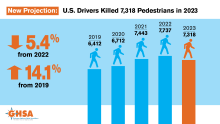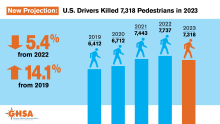A report by the US Governors Highway Safety Association (GHSA) estimates that motorcyclist deaths increased around 9% in 2012, with over 5,000 killed. This is greater than had been expected by the US Government and if the data is confirmed, 2012 will be the 14th out of the last 15 years in which motorcyclist fatalities have increased. This shocking data is in marked contrast to US road fatalities overall, which have dropped. Motorcyclists remain one of the few roadway user groups where no safety improvemen
A report by the US 5188 Governors Highway Safety Association (GHSA) estimates that motorcyclist deaths increased around 9% in 2012, with over 5,000 killed. This is greater than had been expected by the 908 US Government and if the data is confirmed, 2012 will be the 14th out of the last 15 years in which motorcyclist fatalities have increased. This shocking data is in marked contrast to US road fatalities overall, which have dropped. Motorcyclists remain one of the few roadway user groups where no safety improvements can be shown over the last 10 years. This report provides a state-by-state look at motorcyclist fatalities occurring in 2012 and was prepared by Dr James Hedlund of Highway Safety North. Dr Hedlund is a former senior official with the 2467 National Highway Traffic Safety Administration (NHTSA). Most states have reasonably complete fatality counts for at least the first nine months of 2012, enabling the GHSA to project the full year. Dr Hedlund completed similar projections for GHSA for 2009, 2010 and 2011, all of which mirrored the final fatality numbers.
Comparing the first nine months of 2011 to 2012, motorcyclist fatalities increased in 34 states, decreased in 16 states and remained the same in the District of Columbia. Increases occurred in every region and were quite significant in many cases. For example, motorcyclist fatalities jumped 32% and 29% in Oregon and Indiana, respectively, while Pennsylvania saw an 8% increase.
The report notes that the economy is influencing motorcycle use. With the economy improving in 2012 and further strengthening in 2013, more people have disposable income for purchasing and riding motorcycles. At the same time, high fuel prices may cause more individuals to choose fuel-efficient vehicles like motorcycles as their preferred mode of transportation. Dr Hedlund compared gas prices, motorcycle registrations, and motorcyclist fatality trends since 1976. He found that for the entire period fatalities closely track registrations, with significant similarities from 1990 to 2008. As fuel prices increased, motorcycle registrations and fatalities also rose.
A worrying trend is the decrease in states with universal helmet laws according to the GHSA. A helmet law is the only motorcycle safety strategy with a five-star effectiveness rating in the federal government’s highly-regarded publication, Countermeasures That Work. Only 19 states require all riders to wear helmets, down from 26 in 1997. There is a strong push in many states to repeal these laws, and no state has enacted a universal helmet law since Louisiana reinstated its requirement in 2004.
Specifically, the report recommends states increase helmet use as they are proven to be 37% effective at preventing fatal injuries to motorcycle operators and 41% effective for passengers. NHTSA estimates that 706 of the unhelmeted motorcyclists who died in crashes in 2010 would have lived had they worn helmets. Another key move will be to reduce alcohol use as in 2010, 29% of fatally injured riders had a blood alcohol concentration at or above the legal limit, the highest of all motorists. Speeding is another key problem to be tackled as the most recent data suggests 35% of motorcycle riders involved in fatal crashes were speeding, and almost half of these crashes did not involve another vehicle. While all states currently offer training, some courses may not be provided at locations and times convenient for riders and the NHTSA data reveals that in 2010, 22% of motorcycle riders involved in fatal crashes did not have a valid motorcycle license. This compares with 12% of passenger vehicle drivers in fatal crashes. By encouraging licensing, states encourage training. In addition all drivers should be encouraged to share the road with motorcyclists as NHTSA research suggests that when motorcycles crash with other vehicles, the latter usually violates the motorcyclist’s right of way.
Comparing the first nine months of 2011 to 2012, motorcyclist fatalities increased in 34 states, decreased in 16 states and remained the same in the District of Columbia. Increases occurred in every region and were quite significant in many cases. For example, motorcyclist fatalities jumped 32% and 29% in Oregon and Indiana, respectively, while Pennsylvania saw an 8% increase.
The report notes that the economy is influencing motorcycle use. With the economy improving in 2012 and further strengthening in 2013, more people have disposable income for purchasing and riding motorcycles. At the same time, high fuel prices may cause more individuals to choose fuel-efficient vehicles like motorcycles as their preferred mode of transportation. Dr Hedlund compared gas prices, motorcycle registrations, and motorcyclist fatality trends since 1976. He found that for the entire period fatalities closely track registrations, with significant similarities from 1990 to 2008. As fuel prices increased, motorcycle registrations and fatalities also rose.
A worrying trend is the decrease in states with universal helmet laws according to the GHSA. A helmet law is the only motorcycle safety strategy with a five-star effectiveness rating in the federal government’s highly-regarded publication, Countermeasures That Work. Only 19 states require all riders to wear helmets, down from 26 in 1997. There is a strong push in many states to repeal these laws, and no state has enacted a universal helmet law since Louisiana reinstated its requirement in 2004.
Specifically, the report recommends states increase helmet use as they are proven to be 37% effective at preventing fatal injuries to motorcycle operators and 41% effective for passengers. NHTSA estimates that 706 of the unhelmeted motorcyclists who died in crashes in 2010 would have lived had they worn helmets. Another key move will be to reduce alcohol use as in 2010, 29% of fatally injured riders had a blood alcohol concentration at or above the legal limit, the highest of all motorists. Speeding is another key problem to be tackled as the most recent data suggests 35% of motorcycle riders involved in fatal crashes were speeding, and almost half of these crashes did not involve another vehicle. While all states currently offer training, some courses may not be provided at locations and times convenient for riders and the NHTSA data reveals that in 2010, 22% of motorcycle riders involved in fatal crashes did not have a valid motorcycle license. This compares with 12% of passenger vehicle drivers in fatal crashes. By encouraging licensing, states encourage training. In addition all drivers should be encouraged to share the road with motorcyclists as NHTSA research suggests that when motorcycles crash with other vehicles, the latter usually violates the motorcyclist’s right of way.






